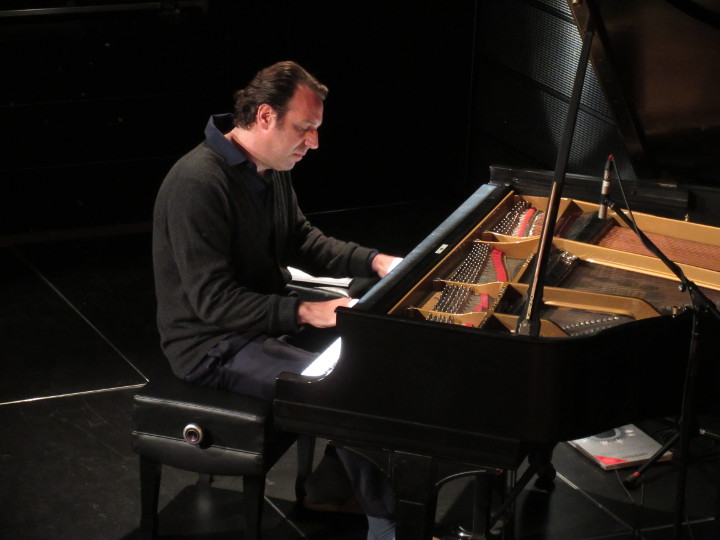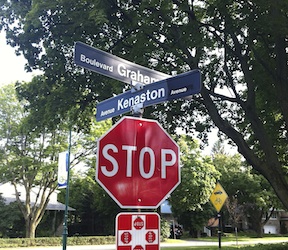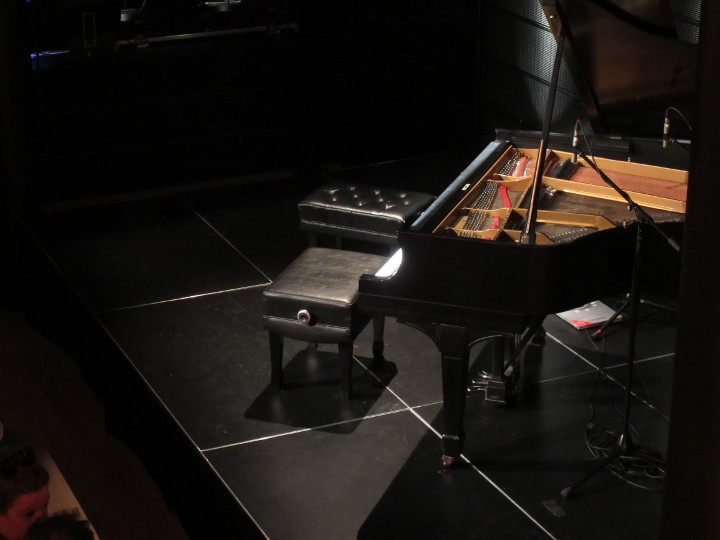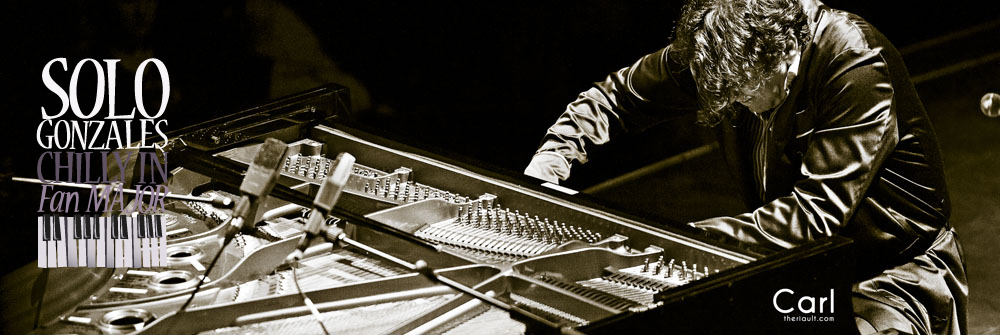 “I play my own music, so I have a direct line to the composer; I know what his intentions were.” – Gonzales on interpretation
“I play my own music, so I have a direct line to the composer; I know what his intentions were.” – Gonzales on interpretation
My son and I were fortunate enough to be part of the sold-out Masterclass lecture at the ‘old and modern’ Centre Phi in Montreal on June 2. The Centre Phi lies at the edge of old Montreal just West of McGill St., not far from where Montreal was originally founded. Old Montreal is unique in that a large section of the original city was preserved, despite pressure over the years to make way for modern buildings and roads. It’s an uncharacteristically hot June day, but the walk down shady cobblestone-lined streets is very pleasant – the old buildings still releasing the winter’s chill that was stored deep within their stone walls. Some of the buildings in old Montreal date back to the 1700s (ancient by North American standards) – a time when the Little St. Pierre River met the mighty St. Lawrence River. Old versus new, historical versus modern, the pressures of North American culture flowing beside a bastion of European value. A city situated on the confluence of two cultures seems like the perfect place to host an entertainer who deftly marries old world craftsmanship with new world sensibilities like no other.
As the showtime neared, the centre filled to capacity and shortly after the scheduled start time, Gonzales walked onto stage to raucous applause. Right from the start, one had the sense that this wasn’t like other Gonzales concerts. Missing, was his trademark robe – replaced by a smart dark cardigan and shirt (and ‘traditional’ slippers), which implied that Gonzales was going to focus on his educational side more than his pure entertainment show. Throughout the lecture, the house lights stayed on, which allowed Gonzales to connect with members of the audience, as opposed to the usual blinding lights of the stage. There were also two special guests sitting close to the front; piano enthusiasts who submitted videos explaining why they would like to have a lesson with Gonzales on-stage (more on those lessons later).
 Gonzales was glad to be back in his hometown, and he started off the lecture with a song that, as he explained, is, “very close to my heart – especially in Montreal.” As many Gonzales fans know, Kenaston (from Solo Piano II) is named after the street in Montreal where Gonzales spent his childhood. The audience certainly felt the warmth and melancholy of Gonzales’ performance – which remained closer to the intimacy of the original than the more ‘expanded’ version he played during the Solo Piano II tour. The fact that Gonzales can reinterpret his songs to suit the occasion led to the first of many lessons: improvisation.
Gonzales was glad to be back in his hometown, and he started off the lecture with a song that, as he explained, is, “very close to my heart – especially in Montreal.” As many Gonzales fans know, Kenaston (from Solo Piano II) is named after the street in Montreal where Gonzales spent his childhood. The audience certainly felt the warmth and melancholy of Gonzales’ performance – which remained closer to the intimacy of the original than the more ‘expanded’ version he played during the Solo Piano II tour. The fact that Gonzales can reinterpret his songs to suit the occasion led to the first of many lessons: improvisation.
Gonzales, influenced by his formal classical and jazz education, continually ‘re-interprets’ his own music, as well as interpreting classical and modern music. For him, improvisation tends to lead to musical ideas – some of which turn into songs. Improvisation is a highly-regarded skill that was practiced by some of music’s greats: Mozart, Handel, Liszt, Bach, Charlie Parker, John Coltrane, Ennio Morricone, John Zorn and so on. Mozart and Beethoven even competed in “improvisation competitions”, which lent even more credence to the theory that most great classical music was borne out of improvisation. There is certainly an art and skill to all but the most basic “noodling” approach to improvisation, and Gonzales demonstrated what one of his improvisations would sound like if he sat down at the piano first thing in the morning. Those lucky enough to have the “Rough Trade” version of Solo Piano II can listen to the track “26 December 2011″, which is comprised of 15 minutes of fascinating improvisation not unlike what Gonzales played at the lecture. For Gonzales, improvisation seems to seep into other areas of his persona: reactive comedy with the audience, interviews, piano battles, and possibly even some freestyle rap. Improvisation as a skill is underrated in most of our lives (not just in music), and we could all use a bit of ‘improv’ at home and at work to keep our creativity flowing.
The difference between an improvised piece and completed piece such as Kenaston is obvious, but parts of Kenaston came from improvisation. What was the path Gonzales followed from improvisation to the emotional impact of Kenaston? The short answer is by combining sounds that connect with you personally, with some of the ‘tricks’ that performers and composers have invented over the years to overcome the fundamental limitations of the piano. Examples included tremolo (not the evil kind), chord progressions, ornamentation and dissonance. With each example, Gonzales explained each technique in detail (what the effect tries to achieve, where is could be used), and played examples from his own pieces (Gentle Threat, Overnight), or from common or ad-lib songs. One example (rubato) included a technique that Gonzales’ good friend Mocky tends to use called “painting”, which “overdubs” a rubato on an existing piece, which adds a layer of “timelessness” to a piece that has an underlying rhythm. The lecture on emotional techniques cumulated in a version of Overnight, which (like the famous all-dressed Montreal bagel) combined all the emotional ingredients to a great effect – and great applause.
After explaining piano techniques, Gonzales introduced the first of two students – Xavier, who headed up on-stage. As promised, Gonzales was extremely ingratiating, and Xavier seemed to feel very comfortable on stage. Xavier turned out to be a fan of Hayden, and deftly played an excerpt of his favourite Hayden piece (after a bit of encouragement from Gonzales). Composers such as Stravinsky and Hayden didn’t leave much room for interpretation – all of the expressiveness was built-into the piece, which reduced the need for any misinterpretations from the performers. Gonzales asked Xavier to play the piece with an abundance of expressiveness, which was somewhat difficult for Xavier, but achieved the goal that sometimes adding expressiveness actually took away from the original intent of the composer. It was clear that Xavier was an accomplished pianist, which is likely why Gonzales asked Xavier to play a version of Othello that was on Xavier’s ‘audition’ video. Xavier’s version employed a great deal of syncopation, ornamentation, and rubato, which created a more ‘playful’ version, which the audience seemed to appreciate.
Perhaps the best part of the lesson came when Gonzales asked Xavier to play an original composition. Xavier was more than happy to oblige and dove into a modern-sounding piano piece with a fairly rich melodic line – somewhat reminiscent of an Elton John song. Gonzales’ overall comment was that the piece was too ‘samey’, and that the Xavier could use reduction to build up to rich chords from simple chords and a one-finger melody. Once Xavier employed the reduction techniques and avoided harmonizing with the melody right away, the piece became far more emotional and modern, with the potential for greater contrast. “Strip the piece down and build it back up from basic elements” – pure genius. With that, Gonzales gave Xavier a hug and sent him back to his seat.
Xavier’s left hand playing reminded Gonzales of an important illusion – where the left-hand accompaniment takes the place of a kind of a band playing. Gonzales demonstrated several left hand techniques found on his Solo Piano records – many of which emulated a rhythm section. Gonzales eventually played the left-hand portion of Dot, which to him, sounded a bit like a polka rhythm. Dot proved to be the perfect segway to the next portion of the lecture.
The next student Gonzales brought on stage was a young boy called Mica, who appeared to be around 8 or 9 years old. Gonzales liked Mica’s audition video not only because Mica played Dot, but by the way Mica ended the video – with an enthusiastic “yeaaaaaaaaa!” Quite reserved, Mica played his version of Dot with great feeling and lovely grace notes – much to the delight of the crowd, who gave him thunderous applause at the end of his performance. Gonzales then accompanied Mica in the upper registers with another rendition of Dot. This version had a lovely, child-like quality to it, and at the end, Mica gave the audience a big “yaaaaaaa”. Mica then received the biggest applause of the night, gave Gonzales a big hug, and headed back to his seat.
After the applause died down, Gonzales (in French) explained how the piano is essentially a percussive instrument, unlike a violin or flute, and that one could definitely setup a drum-like rhythm by alternating left and right hands on the piano keys – much like a drummer. Gonzales himself took up the drums from the age of 9-16 or so, and was the drummer in his first band (with his brother) called “Newton Talks”. In the past, he’s underscored the importance of rhythm in music, and said that there’s nothing sadder than a violin player who can’t “keep the beat”. With that in mind, Gonzales demonstrated a familiar left/right alternating pattern that he filled in with another left/right alternation in the ‘spaces’ between the other notes. At last, Gonzales played a flawless solo piano version of Knight Moves to a now-transfixed audience – complete with a pedal thumping rhythm and fallboard snaps. After the last notes died away, the audience erupted into a standing ovation, to which Gonzales made his exit for the evening.
 As we left our chairs, we had the distinct feeling that we just witnessed a unique and rare event. The opportunity to listen to a world-class musician practically ‘giving away’ the tricks and techniques that took him years to learn and master. This willingness to publicly share to spawn a new generation of musicians is a rare quality in most areas of work. People who strive their entire life to gain skills cannot imagine giving their knowledge away for fear of losing their competitive advantage. But like Tesla Motor’s recent public release of their patents, some companies (and musicians) see benefits and new opportunities for a much larger audience through openness. In Tesla’s case, their intention is to spawn new car manufacturers that will drive electric car technology forward. In Gonzales’ case, he may want to inspire the next generation of musicians – possibly to change the way we think about, listen to, and ultimately enjoy music. To that end, Gonzales’ new notebook – Re-Introduction Etudes – reconnects people with the ancient joy of creating music. Lucky for us, copies were available at the lecture.
As we left our chairs, we had the distinct feeling that we just witnessed a unique and rare event. The opportunity to listen to a world-class musician practically ‘giving away’ the tricks and techniques that took him years to learn and master. This willingness to publicly share to spawn a new generation of musicians is a rare quality in most areas of work. People who strive their entire life to gain skills cannot imagine giving their knowledge away for fear of losing their competitive advantage. But like Tesla Motor’s recent public release of their patents, some companies (and musicians) see benefits and new opportunities for a much larger audience through openness. In Tesla’s case, their intention is to spawn new car manufacturers that will drive electric car technology forward. In Gonzales’ case, he may want to inspire the next generation of musicians – possibly to change the way we think about, listen to, and ultimately enjoy music. To that end, Gonzales’ new notebook – Re-Introduction Etudes – reconnects people with the ancient joy of creating music. Lucky for us, copies were available at the lecture.
After hearing that copies of “Re-Introduction Etudes” sold out in the Toronto Masterclass, we headed down to the Centre Phi right as the doors opened. Although no books were on-sale, there was a table, so we waited and chatted with some of the other people waiting in line. A woman who was entranced at Gonzales’ 2005 “return to Canada” concert at the Théâtre National in Montreal – where Gonzales managed to track down and play the show on his childhood piano. She has been to every Gonzales concert in Montreal since. A young couple who were in attendance at Gonzales’ triple-encore show at the Rialto theatre in 2012. A middle-aged gentleman who seemed to resonate with Gonzales’ message of ‘re-introduction’. All of these people were familiar with Gonzales and his oeuvre, and were anticipating the lesson. A few minutes later, a man came out from the back carrying a well-worn cardboard box filled with factory-sealed copies of “Re-Introduction Etudes”. As it turned out, the man was Malcolm Fraser (a.k.a. The World Provider) – a talented musician and friend from Gonzales’ extended musical family. He cheerfully handed us our copy, and we tore open the shrink-wrap on the impressive spiral-bound notebook. The physical dimensions were somewhere between the Solo Piano and Solo Piano II notebooks. A CD within a sleeve was glued to the inside back cover, which also had a tear-out poster in the style of the artwork featured in the rest of the book. After studying (reading) a few of the pieces, it became clear just how much attention had been paid to every detail of the notebook – so much so, that we’ll have to leave an examination of “Re-introduction Etudes” to another article. Suffice it to say that nothing beats the quality of a masterfully-produced physical copy.
As we left the Centre Phi (which is pronounced “fee” in French), we found ourselves in the twilight of a beautiful Montreal evening. The old buildings were now just silhouettes which lined our walk back down the cobblestone streets until we hit the stark concrete of McGill, which delineates the boundary between the old and the new. Gonzales was born in this beautiful city; a city founded on the union of two rivers and two cultures, which has resulted in one of the most unique metropolitan areas in the world. And like the early explorers of Canada, Gonzales has seen how accessible, lush, and fertile the land is where his little river meets seemingly endless waters. From the top of the vista he has worked so hard to create, he looks out at the thousands of messages in small bottles he released, now floating from his little river into the massive waterway. And he patiently waits for more people to arrive.
